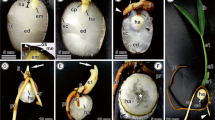Summary
The six genera of the Vitaceæ studied show varying extent of perichalazal growth after fertilization. Ingrowths of rumination are produced by the integumentary tissues as a result of localised growth from the raphe region at the ventral side of the seed and their location in the mature seed is determined by the extent of perichalazal growth. InLeea the perichalaza itself becomes pushed in as an ingrowth and in addition to this four more ingrowths are produced; inCissus, Vitis, Tetrastigma andAmpelocissus the number of ingrowths is only two and these are situated away from the perichalaza; inCayratia the ingrowth is a single dome-shaped structure with two small longitudinal ridges at the inner face.
The nucellus increases after fertilization, and becomes ruminate by the ingrowths of the seedcoat. The endosperm remains quiescent and of small volume until the seed attains almost its mature size, but thereafter grows rapidly and replaces all the nucellus, thereby acquiring the same ruminate configuration. The mature endosperm contains fatty reserves and one druses in each cell.
The mechanical tissue of the mature seedcoat is completely derived from the innermost layer of the outer integument and is of varying layers thick in the different genera. The middle layers of the outer integument become tanniferous to varying extent in the different genera. The innermost layer of the inner integument becomes tanniferous, the outermost becomes spirally thickened and these two persist in the mature seed, whereas the middle layer acts as a nutritive layer and becomes completely crushed. Raphides occur in the seedcoat of all the genera exceptLeea.
Similar content being viewed by others
References
Adkinson, J...Ann. Bot., 1913,27, 133–39.
Corner, E. J. H...New Phytol., 1949,48, 332–64.
Gamble, J. S. ..Flora of the Presidency of Madras, 1918,1.
Gilg, E. .. “Vitaceæ in Engler and Prantl,”Die Natürlichen Pflanzenfam.,3 (5), 1896, Leipzig.
Metcalfe, C. R. and Chalk, L.Anatomy of the Dicotyledons, Clarendon Press, Oxford, 1957,1.
Netolitzky, F.Anatomie der Angiospermensamen, Handbuch der Pflanzenanatomie, Berlin, 1926.
Periasamy, K...J. Madras Univ., 1961,31, 53–58.
—————.. “The ruminate endosperm, I. Development and types of rumination,”Proceedings of the Symposium on Plant Embryology, C.S.I.R., New Delhi, 1962 (In press).
—— and Swamy, B. G. L.J. Indian bot. Soc., 1961,40, 207–16.
Voigt, A...Ann. Jard. Bot. Buitenz., 1888,7, 150–90.
Author information
Authors and Affiliations
Additional information
Communicated by Prof. T. S. Sadasivan,f.a.sc.
Part of thesis approved for the Ph.D. degree of the University of Madras, 1959.
Rights and permissions
About this article
Cite this article
Periasamy, K. Studies on seeds with ruminate endosperm. Proc. Indian Acad. Sci. 56, 13–26 (1962). https://doi.org/10.1007/BF03051525
Received:
Issue Date:
DOI: https://doi.org/10.1007/BF03051525




